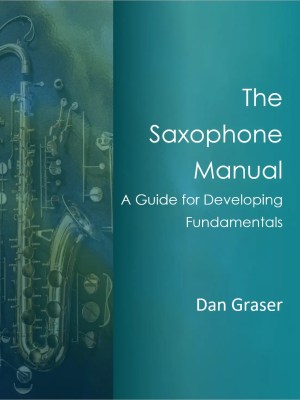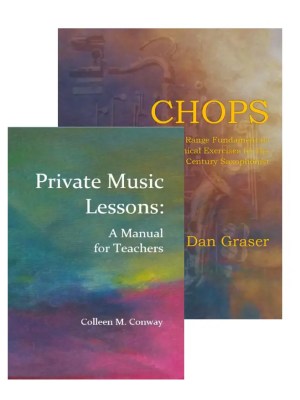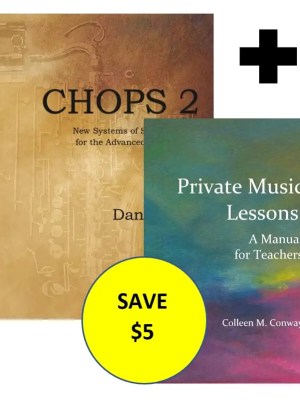Description
Chops 3: The Sinta Quartet Method continues the mission of its 2 predecessors to modernize and update the fundamental areas of saxophone performance and study. This volume focuses entirely on the chamber music fundamentals needed to have a successful saxophone quartet experience and to develop effective rehearsal strategies. Of course, the bulk of your time in rehearsal will be spent on repertoire; however, the addition of warm-ups and fundamentals to the start – and perhaps end – of each rehearsal will allow for greater efficiency in achieving a unified approach to your music.
Saxophone quartet can be the most rewarding music-making you have during your studies as it focuses your attention on blend, intonation, group cohesiveness, and the shared formulation of an interpretation with friends and colleagues. However, it also likely requires that you practice on an instrument with which you’re not as familiar as your primary saxophone. Thus, some suggestions for getting acquainted with your new instrument’s tendencies are given at the outset. Doing some diligent individual work on making your quartet instrument as precisely practiced as your primary instrument will make for much more enjoyable rehearsals.
The main areas of focus for the ensemble exercises are intonation, cueing, uniformity, and blend. Knowing how to properly adjust each note of a chord is an important skill to develop aurally, as is the skill of reading a score and quickly deciphering which member of the chord you’re playing. As such, all exercises are written in full transposed score. Even if you are not yet familiar with transpositions, start with some of the “concert pitch” to saxophone pitch relationships you do know, and build from there while learning to read from a score. Since saxophone music requires that at some point, every member or occasionally the entire group cue together, cueing exercises focusing on developing this skill are included both individually and also in tandem with the aforementioned intonation exercises. Uniformity and Blend are the final areas and though frequently used interchangeably, they are specified here. Uniformity exercises focus on performing moving lines, articulating, using vibrato, beginning and releasing notes, and changing dynamics as a group. Blend exercises focus on timbre specifically and matching tone color across registers and instruments. As you can imagine, the two are linked but at various stages groups often find they need to focus. These exercises allow for that specific type of focus.
Features:
- Resources for developing awareness of your specific quartet instrument
- Full Score notation for all exercises
- A getting started chapter for young and new groups to make the most of their first rehearsals.
- Advanced and fun exercises for intonation, cueing, uniformity, and blend.
- Musical examples as a culminating study for all of the aforementioned areas.
By working with this volume, both students and quartet coaches will be able to employ an arsenal of exercises designed to address the most basic and the most advanced issues of saxophone chamber music. Upon completion the ensemble will have gained the ability to read from a transposed score as well as greater aural awareness of their timbre, intonation, chord qualities, and fundamentals impacting blend and uniformity. Through careful application of these exercises rehearsals will become much more fun and engaging, and performances will become much more cohesive and, as a result, more powerful.











Mark Smith –
Chops 3 is an incredible resource for quartets and coaches! The wealth of exercises and level of detail that has gone into this method is astounding. Topics ranging from intonation and balance to cueing and how to rehearse are covered in great detail. The exercises presented here are an excellent foundation for any group, beginner or advanced, wanting to take their playing to the next level. Chops 3 has already impacted the way I go through fundamentals and warm-ups with student quartets, and I expect my students and I will be using these methods for many years to come. Thank you, Sinta Quartet, for this unbelievably amazing resource!
-Mark Smith, Award-Winning Saxophone Quartet Coach
Instructor of Saxophone, Hebron High School
Zach Shemon –
It is with great pride that I endorse the methods developed by the members of the Sinta Quartet, my long time friends, classmates, and esteemed colleagues. The insights in this volume—getting inside the collective mind of a chamber ensemble of the highest caliber—are invaluable. The authors have distilled all the information needed to guide a saxophone quartet from its inception through the various stages of development into a concrete, easy-to-follow method, providing clarity to what can be a daunting venture.
-Zach Shemon, Alto Saxophonist, PRISM Quartet
Associate Professor of Saxophone, University of Missouri – Kansas City Conservatory
Michael Haithcock –
Having witnessed the formation of the Sinta Quartet, and having followed their meteoric rise in the world of chamber music over the last decade, I can simply offer my highest endorsement as well as appreciation for what they have accomplished. Their success is built on a rigorous commitment to each other, their individual artistry, and an artistic process which has driven their evolution. Chops 3 outlines in detail the components of their methodology and offers invaluable insight for ensembles that aspire to similar success. While the point of view is from their experience as saxophonist, fantastic information is within for any chamber or large ensemble seeking to raise the bar of their own quality of performance!
-Michael Haithcock, Director of Bands and Thurnau Professor of Music
University of Michigan
Chien-Kwan Lin –
This book provides the perfect blend of methodology and practical exercises to build the foundation for a successful quartet experience. Honing in on the details of refined chamber musicianship, it provides a clear outline for groups to follow, whether they are advanced or newly-established. The topics covered are extensive and comments are remarkably insightful. It catalogs many of the essential elements in chamber music making which will be tremendously beneficial to my students. Thank you to the Sinta Quartet for providing this valuable resource to our community. This is a must-read for all saxophone quartet enthusiasts!
– Chien-Kwan Lin, Professor of Saxophone, Eastman School of Music